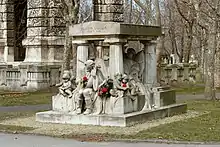Lujza Blaha
Lujza Blaha (Ludovika Reindl; 1850–1926) was a Hungarian actress and singer. She was known as "the nation's nightingale", an epithet given her by writer Mór Jókai.[1][2]

Personal life
Ludovika Reindl was born 8 September 1850 in Rimaszombat (today Rimavská Sobota, Slovakia).[1] She married Ján Blaha, a Czech conductor in the imperial army, when she was 15 years old. He died five years later, but she kept his surname all her life despite marrying twice more.[2] Despite being considered a "national icon" during her lifetime, she opposed the dignified "national prima donna" that was being thrust upon her and often crossed the taboos of the epoch by being sexually provocative both on stage and in her private life.[3][4]
She died 18 January 1926 in Budapest.[1] She was buried in the Kerepesi Cemetery, and her funeral drew a crowd of 100,000, including a gypsy band of 200 musicians.[2][5]
Career
Blaha's parents were travelling actors, and she first performed aged 15 in Subotica. She received acting training from the Budapest School of Dramatic Arts.[6]
She joined the national theatre five years later and between 1871 and 1900 she played almost 200 parts in plays, mostly Hungarian "folk plays" or "Volksstuck", patriotic plays celebrating peasant life.[1][2] Apart from her theater work, she would also draw crowds at balls, the banquets and torchlight music events organised by the Mulató-klub (The Club of Amusements), and she was also active as an operetta singer.[7][8]
She also appeared in two silent films. The first, A táncz ("Dance", 1901) was an educational documentary short by Pekár Gyula, while the second, A nagymama (The Grandmother, 1916) sees her play the title role in the Alexander Korda film.[9]
She played an important role in popularizing Hungarian gypsy songs.[2] Her final performance in 1908 was in Csiky Gergely's play Nagymama ("grandmother").[1]
Legacy
Lujza Blaha Square in central Budapest was named for her in 1920 to celebrate her 70th birthday.[2] It was the site of the Hungarian National Theatre from 1908 to 1965; this was demolished because of construction of Blaha Lujza tér metro station.[10] Her Neoclassical summer home in the resort town of Balatonfüred, on the northern shore of lake Balaton, has been turned into a hotel bearing her name and is a minor tourist attraction of the town.[11]

Her tomb in Kerepesi Cemetery has been described as "one of the finest pieces in the Hungarian national pantheon".[2]
Hungarian indie-pop band Blahalouisiana was founded in 2013.
References
- "Lujza Blaha". Encyclopedia Britannica. Retrieved 16 August 2019.
- Molnár, Miklós M. (2018). 33 Hungarian Histories: Hungarian Identity Through Portraits. Catch Budapest. Retrieved 16 August 2019. "First published in the Time Out Budapest magazine's monthly column "Magyar of the Month" (2009-2011)"
- Heltai, Gyöngyi (2016). "Star prima donnas as lieux de mémoire at home and abroad" (PDF). World Literature Studies. 8 (4): 64–76. ISSN 1337-9275.
- Tari, Lujza (2017). "Magyarnóta". In Prato, Paolo; Horn, David (eds.). Bloomsbury Encyclopedia of Popular Music of the World (PDF). Vol. 11. New York and London: Bloomsbury Academic. pp. 473–478. ISBN 978-1-5013-2610-3.
- Kaszás, Fanni. "Best of Budapest: 6 Famous Women and Their Graves". Hungary Today. Retrieved 16 August 2019.
- Osnes, Beth; Osnes, Mary (2001). Acting: An International Encyclopedia. Santa Barbara, CA, Denver, CO and Oxford: ABC-CLIO. p. 145. ISBN 9780874367959.
- Berki, Tímea (2011). "From Grigore Moldovan to Moldován Gergely - A Career in Homeland" (PDF). Acta Universitatis Sapientiae, Philologica. 3 (2): 156–166. ISSN 2067-5151.
- Bozó, Péter (14 October 2016). "Operetta in Hungary (1859–1960)*". Hungarian Academy of Sciences: Institute for Musicology. Retrieved 28 September 2019.
- Cunningham, John (2004). Hungarian Cinema: From Coffee House to Multiplex. London and New York: Wallflower Press. p. 12. ISBN 9781903364796.
- Hoorn, Mélanie van der (2009). Indispensable Eyesores: An Anthropology of Undesired Buildings. Remapping Cultural History. Vol. 10. New York and Oxford: Berghahn Books. p. 185. ISBN 9781845459215.
- Longley, Darreb (2010). The Rough Guide to Hungary. London: Rough Guides UK. ISBN 9781405387156.
External links
- Lujza Blaha at IMDb
- "Lujza Blaha". Billion Graves.